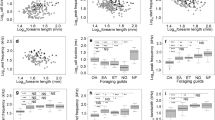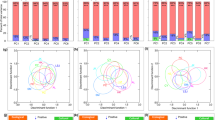Abstract
The auditory thresholds of the AN2 interneuron and the behavioural thresholds of the anti-bat flight-steering responses that this cell evokes are less sensitive in female Pacific field crickets that live where bats have never existed (Moorea) compared with individuals subjected to intense levels of bat predation (Australia). In contrast, the sensitivity of the auditory interneuron, ON1 which participates in the processing of both social signals and bat calls, and the thresholds for flight orientation to a model of the calling song of male crickets show few differences between the two populations. Genetic analyses confirm that the two populations are significantly distinct, and we conclude that the absence of bats has caused partial regression in the nervous control of a defensive behaviour in this insect. This study represents the first examination of natural evolutionary regression in the neural basis of a behaviour along a selection gradient within a single species.


Similar content being viewed by others
References
Balakrishnan R, Pollack GS (1996) Recognition of courtship song in the field cricket, Teleogryllus oceanicus. Anim Behav 51:353–366
Beveridge M, Simmons LW (2005) Microsatellite loci for the Australian field cricket Teleogryllus oceanicus and their cross-utility in Teleogryllus commodus. Mol Ecol Notes 5:733–735
Borowsky RB, Wilkens H (2002) Mapping a cave fish genome: polygenic systems and regressive evolution. J Heredity 93:19–21
Chopard L (1967) Gryllides. In: Beier M (ed) Orthopterorum Catalogus, Pars 10. Uitgevrij Dr W Junk, 's-Gravenhage, pp 1–211
Churchill S (1998) Australian bats. New Holland, Sydney
Cornuet J-M, Luikart G (1996) Description and power analysis of two tests for detecting recent population bottlenecks from allele frequency data. Genetics 144:2001–2014
Darwin C (1859) On the Origin of Species. John Murray, London
Faulkes Z, Pollack GS (2000) Effects of inhibitory timing on contrast enhancement in auditory circuits in crickets (Teleogryllus oceanicus). J Neurophysiol 84:1247–1255
Fong DW, Kane TC, Culver DC (1995) Vestigialization and loss of nonfunctional characters. Ann Rev Ecolog Syst 26:249–268
Fullard JH (1994) Auditory changes in noctuid moths endemic to a bat-free habitat. J Evol Biol 7:435–445
Fullard JH, Dawson JW, Otero LD, Surlykke A (1997) Bat-deafness in day-flying moths (Lepidoptera, Notodontidae, Dioptinae). J Comp Physiol A 181:477–483
Fullard JH, Ratcliffe JM, Soutar AR (2004) Extinction of the acoustic startle response in moths endemic to a bat-free habitat. J Evol Biol 17:856–861
Fullard JH, Ratcliffe JM, Guignion C (2005) Sensory ecology of predator–prey interactions: responses of the AN2 interneuron in the field cricket, Teleogryllus oceanicus to the echolocation calls of sympatric bats. J Comp Physiol A 191:605–618
Fullard JH, Ratcliffe JM, ter Hofstede H (2007) Neural evolution in the bat-free habitat of Tahiti: partial regression in an anti-predator auditory system. Biol Lett 3:26–28
Goudet J (1995) FSTAT (version 1.2): a computer program to calculate F-statistics. J Heredity 86:485–486
Haldane JBS (1933) The part played by recurrent mutation in evolution. Am Nat 67:5–19
Harrison L, Horseman G, Lewis B (1988) The coding of the courtship song by an auditory interneurone in the cricket Teleogryllus oceanicus (Le Guillou). J Comp Physiol A 163:215–225
Hill KG, Loftus-Hills JJ, Gartside DF (1972) Premating isolation between the Australian field crickets Teleogryllus commodus and T. oceanicus (Orthoptera: Gryllidae). Aust J Zool 20:153–163
Hutchings M, Lewis B (1984) The role of two-tone suppression in song coding by ventral cord neurones in the cricket Teleogryllus oceanicus (Le Guillou). J Comp Physiol A 154:103–112
Kevan DKM (1990) Introduced grasshoppers and crickets in Micronesia. Bol Sanid Veg 20:105–123
Kimura M, Crow JF (1964) The number of alleles that can be maintained in a finite population. Genetics 49:725–738
Latimer W, Lewis DB (1986) Song harmonic content as a parameter determining acoustic orientation behaviour in the cricket Teleogryllus oceanicus (Le Guillou). J Comp Physiol A 158:583–591
Marsat G, Pollack GS (2006) A behavioral role for feature detection by sensory bursts. J Neurosci 26:10542–10547
Marsat G, Pollack GS (2007) Efficient inhibition of bursts by bursts in the auditory system of crickets. J Comp Physiol A 193:625–633
Mayr E (1942) Systematics and the origin of species. Columbia University Press, New York
Miller LA, Surlykke A (2001) How some insects detect and avoid being eaten by bats: tactics and countertactics of prey and predator. Bioscience 51:570–581
Moiseff A, Hoy RR (1983) Sensitivity to ultrasound in an identified auditory interneuron in the cricket: a possible link to phonotactic behavior. J Comp Physiol 152:155–167
Moiseff A, Pollack GS, Hoy RR (1978) Steering responses of flying crickets to sound and ultrasound: mate attraction and predator avoidance. Proc Natl Acad Sci USA 75:4052–4056
Narbonne R, Pollack GS (2008) Developmental control of ultrasound sensitivity by a juvenile hormone analog in crickets (Teleogryllus oceanicus). J Insect Physiol 54:1552–1556
Nolen TG, Hoy RR (1984) Initiation of behavior by single neurons: the role of behavioral context. Science 226:992–994
Otte D, Alexander RD (1983) The Australian crickets (Orthoptera: Gryllidae). Academy of Natural Sciences of Philadelphia, Philadelphia
Piry S, Luikart G, Cornuet J-M (1999) BOTTLENECK: A computer program for detecting recent reductions in the effective population size using allele frequency data. J Heredity 90:502–503
Pollack GS (1998) Neural processing of acoustic signals. In: Hoy RR, Popper AN, Fay RR (eds) Comparative hearing: insects. Springer, New York, pp 139–196
Pollack GS, El-Feghaly E (1993) Calling song recognition in the cricket Teleogryllus oceanicus: comparison of the effects of stimulus intensity and sound spectrum on selectivity for temporal pattern. J Comp Physiol A 171:759–766
Pollack GS, Martins R (2007) Flight and hearing: ultrasound sensitivity differs between flight-capable and flight-incapable morphs of a wing-dimorphic cricket species. J Exp Biol 210:3160–3164
Popov AV, Shuvalov VF (1977) Phonotactic behaviour of crickets. J Comp Physiol 119:111–126
Raymond M, Rousset F (1995) GENEPOP (version 1.2): population genetics software for exact tests and ecumenicism. J Heredity 86:248–249
Reznick DN, Ghalambor CK (2001) The population ecology of contemporary adaptation: what empirical studies reveal about the conditions that promote adaptive evolution. Genetica 112–113:183–198
Romero A, Green SM (2005) The end of regressive evolution: examining and interpreting the evidence from cave fishes. J Fish Biol 67:3–32
Slatkin M (1987) Gene flow and the geographic structure of natural populations. Science 236:787–792
Strausfeld NJ, Seyan HS, Wohlers D, Bacon JP (1983) Lucifer yellow histology. In: Strausfeld NJ (ed) Functional neuroanatomy. Springer-Verlag, Berlin, pp 132–155
Surlykke A, Skals N, Rydell J, Svensson M (1998) Sonic hearing in a diurnal geometrid moth, Archiearis parthenias, temporally isolated from bats. Naturwissenschaften 85:36–37
Tinghitella RM (2008) Rapid evolutionary change in a sexual signal: genetic control of the mutation ‘flatwing’ that renders male field crickets (Teleogryllus oceanicus) mute. Heredity 100:261–267
van Dyck SM, Strahan R (2008) The mammals of Australia, 3rd edn. Reed New Holland, Sydney
Vestjens WJM, Hall LS (1977) Stomach contents of forty-two species of bats from the Australasian region. Aust Wildl Res 4:25–35
Weir BS, Cockerham CC (1984) Estimating F-statistics for the analysis of population structure. Evolution 38:1358–1370
Yager DD (1990) Sexual dimorphism of auditory function and structure in preying mantises (Mantodea; Dictyoptera). J Zool (Lond) 221:517–37
Yager DD (1999) Structure, development, and evolution of insect auditory systems. Microsc Res Tech 47:380–400
Zuk M, Rotenberry JT, Simmons LW (2001) Geographical variation in calling song of the field cricket Teleogryllus oceanicus: the importance of spatial scale. J Evol Biol 14:731–741
Zuk M, Rotenberry JT, Tinghitella RM (2006) Silent night: adaptive disappearance of a sexual signal in a parasitized population of field crickets. Biol Lett 2:521–524
Acknowledgements
For assistance while in the field, we thank Neil Davies and the staff of the Richard B. Gump South Pacific Research Station (Moorea, Polynésie française), Gerald McCormack (Cook Islands Natural Heritage Project, Rarotonga, Cook Islands), and Chris R. Pavey (Department of Natural Resources, Environment and the Arts, Australia). We thank David Fang of the UC Riverside Genomics Center for assistance with the microsatellite analysis and Cheryl Hayashi for laboratory space. We also thank Michelle Venance, Steve Fynk, Millie Engel, Shannon Venance, and Maura Purdon for their field proficiency at cricket collecting. This work was supported by the Natural Sciences and Engineering Research Council of Canada Discovery Grants to J.H.F and G.S.P., a Journal of Experimental Biology Traveling Fellowship to H. M. t. H., a National Science Foundation Grant Doctoral Dissertation Improvement Grant to R.M.T. and M.Z., and a University of California Pacific Rim Mini-Grant to R.M.T. Studies were carried out in accordance with permits issued by the Délégation à la Recherche (Polynésie française), the Cook Islands Foundation for National Research (Cook Islands), and the Department of the Environment and Heritage and Northern Territory Parks and Wildlife (Australia).
Author information
Authors and Affiliations
Corresponding author
Rights and permissions
About this article
Cite this article
Fullard, J.H., ter Hofstede, H.M., Ratcliffe, J.M. et al. Release from bats: genetic distance and sensoribehavioural regression in the Pacific field cricket, Teleogryllus oceanicus . Naturwissenschaften 97, 53–61 (2010). https://doi.org/10.1007/s00114-009-0610-1
Received:
Revised:
Accepted:
Published:
Issue Date:
DOI: https://doi.org/10.1007/s00114-009-0610-1




